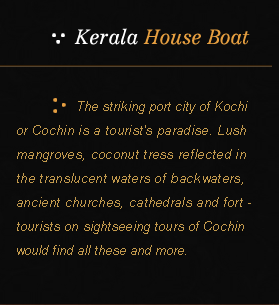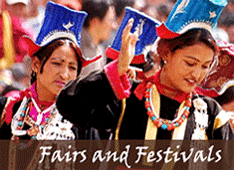
Location : Chennai - Kanchipuram - Mahabalipuram - Pondicherry - Tranquebar - Chettinad - Madurai - Thekkady - Kumarakom - Alleppey - Cochin - Goa - Badami - Hospet - Hassan - Mysore - Bangalore.
Chennai Arrival:
COMPANY REPRESENTATIVE will receive you on arrival at the airport and transfer to the hotel.
Chennai was established only in the 17th century by the British, some parts of the city like Triplicane and its outskirts are almost 2000 years old. The British on settling developed it into a major urban centre and naval base. By the 20th century, it had become an important administrative centre, as the capital of the Madras Presidency.
The city's former name, Madras, is derived from Madraspatinam, a fishing village north of Fort St. George. There is little agreement among researchers about the exact origin of the name Madraspatinam. Some believe that the Portuguese, who arrived in the area in the 16th century, may have named the village Madre de Deus. Others believe that the village's name came from the once prominent Medeiros family (variously known as Madera or Madra in succeeding years) of Portuguese origin, which had consecrated the Madre de Deus Church in the Chennai locality, Santhome, in 1575. It is uncertain whether the name 'Madraspatinam' was in use before European influence.
Sometime after the British gained possession of the area in the 17th century, the two towns, Madraspatinam and Chennapattinam, were merged. The British referred to the united town as Madraspatinam. The state government officially changed it to Chennai in 1996, at a time when many Indian cities were being renamed.
Chennai is an important center for Carnatic Music and hosts a large cultural event, the annual Madras Music Season, which includes performances by hundreds of artists. The city has a vibrant theatre scene and is an important centre for the Bharatnatayam, a classical dance form. The Tamil film industry, one of the largest film industries in India, is based in the city; the soundtracks of the films dominate its music scene.
Overnight will be at Chennai.
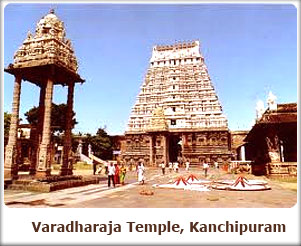 Day 02
Day 02
Chennai – Kanchipuram - Mahabalipuram:
By Road 75Kms/02 hrs
After breakfast proceed for the sightseeing.
Fort ST. George: was built in 1640 AD, by the British East India Company under the direct supervision of Francis Day and Andrew Cogon. This place achieved its name from Saint George, the patron saint of England. The fort houses Saint Mary's Church and fort museum. Saint Mary's Church the oldest Anglican Church built in 1680 and the tombstones in its courtyard are the oldest British tombstones in India.
San Thome Basilica: at the south end of Marina Beach was named after Saint Thomas "doubting apostle of Jesus Christ". It is believed he has come to Madras in 52 AD and kills at St. Thomas Mount just outside the city in 78 AD. Built in 16th Century by the Portuguese, in 1896 it was made a basilica. The beautiful stained glass window at the basilica portrays the story of St Thomas and the central hall has 14 wooden plaques depicting scenes from the last days of Christ.. In the cathedral is a 3ft. high statue of Virgin Mary which is believed to have been brought from Portugal in 1543
Theosophical Society: formed to facilitate and encourage the study of comparative religion, philosophy and science is situated in beautiful sylvan settings in Adyar. The society was founded by Madame Blavatsky and Col. Olott in USA, and later moved to Adyar in 1882. Apart from shrines of all faiths and the peaceful Garden of Remembrance, there is a 95-year old library which has a very good collection of rare Oriental manuscripts written on palm leaves and parchment
Rippon Building: Another pride of Chennai city, this 100 year old building was named after Governor Lord Rippon, the father of self-government in India. The Chennai Corporation and its council are functioning in this building. (Entry time – 10 am to 03 pm)
Kapaleeswarar Temple: Dedicated to Lord Shiva, Kapaleeswarar temple has inscriptions from the 13th century A.D. The temple 'Gopuram' (tower) is in the characteristic Dravidian style of architecture. The walls and pillars of temple have very delicate and intricate carvings which depict the scenes from Hindu mythology.
Drive to Mahabalipuram visiting Kanchipuram enroute.
Kanchipuram: Kanchipuram is a small rural town about 75 km from Chennai (Madras) in the state of Tamilnadu. It also serves as the district head quarters for the Chengalpattu district. Its economy is entirely dependent on tourism and the well established handloom industry. Silk sarees manufactured here are one of the best in the entire world. Is one of the India’s seven sacred cities it was the historical Capital of the Pal lavas. This city is also a world renowned for the gorgeous hand woven silk. Saris of myriad rich colors, noted for their shine, finish and matchless beauty. The Exquisite silk saris are woven from the pure mulberry silk in contrasting colors and have an enviable reputation for luster, durability and finish.
Continue drive to Mahabalipuram. Reach Mahabalipuram and check into the hotel.
Mahabalipuram or Mamallapuram was an ancient port city on the Coromandel Coast faces the Bay of Bengal, built by the Pallava Dynasty in the 7th century. It was named after the cruel demon king Mahabali, who was slayed by Goddess Durga, and is an important World Heritage Site today. It is 60kms from Chennai, and can be reached by the scenic East Coast Road.
It was during the reign of King Narasimha Varman I, the name Mahabalipuram was changed. It was renamed Mahabalipuram which is called till now. There is a story behind. The name Mamallapuram king Narasimha Varman I was a great and valiant warrior. He was given the title Mamalla which means ‘the great wrestler’ so the name was converted from Mahabalipuram to Mahabalipuram considering the great king and his achievements.
The richness in Mahabalipuram was not known to many, as these Pallavas did not outlet and expose their quality and innovative creations to the outer world for obvious reasons. The aestheticism in Mahabalipuram was hidden until the late 185h century. What is special about Mahabalipuram? Of course every one can point out the rock - cut caves, temples made from a single rock, temples and strives of different structures, and bas-reliefs which are so artistic and sheer creativity. Mamallapuram is referred as an ‘open-air museum’. The great Pallava kings Narasimha I and Rajasimha have well preserved these stylistic qualities that one enjoys in Mahabalipuram even in the present day.
The beauty of the place is not only due to these architecture but the vast casuarinas trees, the silvery sandy beach the classical hand male crafts around have made them all to form what is a collective splendor. Any visitor who visits Mahabalipuram will remain startled and intoxicated with the grandeur. They feel hand hearted and more out from this historical and fascinating tourist spot.
Mahabalipuram is known for the beautiful historical monuments that were built mostly during the Pallava Dynasty in the form of rock cut caves and temples. It’s beautiful and unspoilt beaches stretching for miles, and lined by groves of casuarinas is another great attraction.
Buy stone carvings made by the local artists; chill on the sandy beaches; drink beer and try the local cuisines.
Overnight will be at Mahabalipuram.
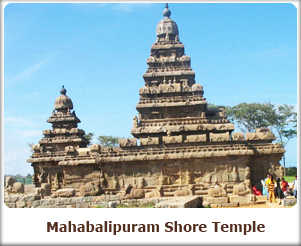 Day 03
Day 03
Mahabalipuram:
Breakfast will be at the hotel.
Enjoy visit to the following places:
Caves: The Varaha Cave shows two incarnations of Vishnu-Varaha (boar) and Vamana (dwarf) along with four panels of the famous Pallava doorkeepers in contemplative reverie. It is the lyrical softness and grace of these supposed to be macho-guards that make them attract the attention of the tourists. The 7th century Mahisasurmardini Cave has fine bas-reliefs on its panels while the Dharmaraja Cave sports three empty shrines. The other highlights of these caves are the Somaskanda, masterpiece of 'dhwani' (the art of suggestion) depicting Lord Vishnu and a huge theatrical panel showing Goddess Durga's fight with the demon Mahishasura. Just 5 km from the city is another 7th century cave called Tiger Cave, a rock-cut shrine.
Arjuna's Penance: Arjuna's Penance is 27 metres long and 9 metres high bas-relief believed to be the world's largest bas-relief. It consists of two huge boulders with a cleft in the rock that depicts the descent of the Ganga on Earth to fulfill the wish of King Bhagiratha to redeem the cursed souls of his ancestors. The carvings depict two large elephants, scenes from the tales of Panchatantra, a forest with tribal people, all forms of animal life and graceful women beaming with inner beauty. The whole scene seems to have a subtle touch edge of humor that is evident in the cat doing rigorous penance against an ascetic.
Rathas: The famous Rathas or Chariots are situated at the southern extreme of Mahabalipuram. Known as the Paanch Pandava Rathas, after the five characters of Mahabharata, four of them are carved out of a single rock. The Draupadi and Arjuna Rathas are square in shape while the Bhima Ratha is linear in shape. Dharamraja Ratha is tallest of all and Nakula-Sahadeva Ratha is apsidal.
Krishna Mandapam: One of the earliest rock-cut temples of Mahabalipuram, its walls depicts scenes of Krishna's pastoral life. One of them depicts Krishna lifting the Govardhan Parvat on his little finger to protect his people from wrath of the Rain God, Indra.
Shore Temple: The best of all at Mahabalipuram is its Shore Temple. It houses one Vishnu temple and two Shiva temples that are all architectural masterpieces in themselves. The sea waves lashing all around make for pretty scenery for the temples.
You could also visit the Sculpture Museum, home to many beautiful sculptures, and the old and new lighthouses which give you a panoramic view of sea.
Overnight will be at Mahabalipuram.Day 04
Mahabalipuram – Tiruvannamalai – Pondicherry:
By Road 112Kms/03hrs
After breakfast drive to Tiruvannamalai a pilgrim centre with an ancient temple of Lord Shiva.
After lunch at local restaurant, proceed to Pondicherry. Reach and check into the hotel.
Pondicherry is a Union Territory of India. It is a former French colony, consisting of four non-contiguous enclaves, or regions, and named after the largest region, Puducherry. The territory was known as Pondicherry until 2006 when it was given the name for which the region was known prior to foreign rule. There are four districts which comprise this territory namely Pondicherry, Karaikal, Yanam and Mahe. Pondicherry is referred by names such as ‘Quintessence of French Culture’, ‘India’s Little France’ and ‘The French Riviera of the East’. This territory was under the French rule for nearly 281 years. Still it has the French flavor in it as one can see by the grand colonial mansions, beautiful boulevards, and placid promenades, spellings on sign boards and buildings, names of roads and public places.
The Union Territory of Pudhucherry (earlier Pondicherry) comprises of the four unconnected, erstwhile French settlements of Pudhucherry, Karaikal, Mahe and Yanam. While Karaikal lies 150 km south of Pudhucherry on the east coast, Mahe is on the Malabar Coast and Yanam in the East Godavari district of Andhra Pradesh.
Tourist attractions in Pondicherry lie in its ambience. Old French style buildings, churches and museums, tree-lined boulevards along the seashore would remind you of a bygone era. The Laidback Township, pristine beach and the palm trees swaying in breeze bring a slice of serenity. The only sound you can hear is the waves crashing against the rocks and the chirping of the birds.
But to cap it all, the Auroville Ashram is the biggest of all tourist attractions in Pondicherry. Just because of it, the destination of Pondicherry exudes a spiritual aura. For the weary soul, this is an ideal retreat. Any evening head for the Ashram meditate, soothe the battered psyche.
Drive to visit Aurobindo’s Ashram which is also known as “the city of dawn”. The place is 10 km north of Pondicherry. This ashram promotes Shri Aurobindo’s ideas in bringing about a synthesis of Yoga and modern science, so as to unite the spirit and matter.
Enjoy heritage walks, cover French and Tamil sectors.
Overnight will be at Pondicherry.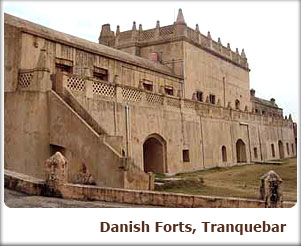 Day 05
Day 05 Pondicherry – Tranquebar:
By Road 120Kms/03hrs
Breakfast will be at the hotel.
Drive to TRANQUEBAR. Check in at the BUNGALOW ON THE BEACH – It is not a building constructed as some activity-laden resort for beach hoppers, but a building that was there organically as part of this small port’s heritage and has now been nicely restored from its state of dilapidation. It has fat round columns, large wooden doors, ventilators, pillared portico, wooden rafters holding up the ceiling and lot of charm.
Danish Forts, British bungalows, German missionaries, Portuguese trade – Clearly, this has to be India. This place is very different from any other place in India and has been overlooked by all in favor of the “tourist – itinerary” which is very common and does not let one discover India.
Tranquebar (Tarangambadi) is a coastal town 24km south of Chidambaram, close to Srikazhi. Interestingly this sleepy little town was an important Danish settlement. The Danish East India Company purchased this piece of land from Raghunatha Nayaka in 1620 and it was transferred to King Christian IV in 1624. Tranquebar continued to be the base for all Danish commercial activities in South India, till the British gained control of the territory in 1807. Denmark finally regained control in 1814, but in the years to come Tranquebar could not regain its former glory and faded into oblivion. The remarkably intact Danesborg Fort, which overlooks the sea, was built in 1620 by the first Danish Governor, Ovo Gedde. The fort has a small museum, which has an interesting collection of maps, documents, weapons and other artefacts. Tranquebar is also home to the New Jerusalem Church of the Evangelical Lutherans, which was associated with Bartolomeus Ziegenbalg, the first Lutheran missionary in South India, who was responsible for the translation of the New Testament into Tamil. The Danish Church and the Town Gateway are the other reminders of the Danish adventures in India. The Beach here is clean and inviting.
Enjoy the hotel and the beach.
Overnight will be at TRANQUEBAR.
Day 06
Tranquebar:
Enjoy breakfast and then the day at the peaceful destination.
Visit the Danish Fort and the Shore Temple. It is best to feel the culture of the place and know of the history.
Overnight will be at Tranquebar.
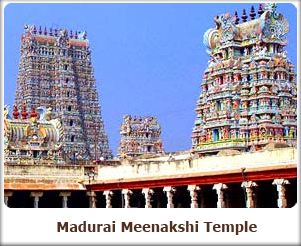 Day 07
Day 07
Tranquebar – Chettinad – Madurai:
By Road 280Kms/06 hrs
Breakfast will be at the hotel.
Drive to Madurai enroute visiting Chettinad
The traditional CHETTINAD houses are made on an area of 2500 sq ft having around 60 to 70 rooms. They were built almost 100 years back. They were made of lime, sand and egg yolk especially imported from Rangoon. The construction material, decor items and furnishings were mostly imported from East Asia Europe. The chandeliers and teak came from Burma, crockery from Indonesia, marble from Italy, wall-to-wall mirrors from Belgium and crystals from Europe. French and other European destinations inspired the woodwork and stonework.
The city of Chettinad located along the coast of Tamil Nadu is also renowned for its rich Cultural Heritage and is one of the major Tourist Destinations in South India. The architectural grandeur of the place is worth mention and one cannot deny the exquisite array of cultural extravaganza that lures the tourist to this destination. The splendid mansions, ancient houses stand boldly exhibiting the magnificent architectural skill of the people of Chettinad.
The houses in Chettinad has been erected on a rectangular plot, across two streets, they have superb interior planning. If you come to see one of these buildings you would wonder at the architectural skill of the ancient artists who had the talent to erect such magnificent structures without the aid of the Interior Decorators! The 100 years old Chettinad Palace is a special Tourist Attraction at this place and one can hardly deny the splendor of the artifact. It has been constructed with materials brought from Italy and Burma, Indonesia and Belgium.
Continue drive to Madurai. Reach Madurai and check into the hotel.
Traveling to Madurai is always a humbling experience for a discerning tourist as the holy city has some of the grandest temples in its womb that make your visit more of a pilgrimage. The city is among the oldest in India, a flourishing seat of art and culture since the Sangam period.
One of the oldest cities of India, with a cultural heritage dating back to 2,500 years, Madurai is situated on the banks of the River Vaigai and is the second largest city of Tamil Nadu.
The city was the capital of the Pandyas and later the Nayakas and is famous for its Meenakshi temple dedicated to Sundareshvara (Shiva) and his consort Meenakshi (Parvati).
Madurai is derived from the name Madhurapuri, standing for the nectar that was showered upon the city as blessings from Lord Shiva's locks.
Overnight will be at Madurai.
Day 08
Madurai:
After breakfast proceed for city tour of Madurai.
Meenakshi Amman Temple: The city of Madurai is originally built around the Meenakshi temple. Though there are many temples in the city, Meenakshi temple outdoes all with its sheer magnificence and splendor of architecture. You can marvel the temple's flawless Dravidian Architecture and be a part of devotees who throng the temple from all over India. If you wished to have a bird's eye view of the city, you could also climb the southern Gopuram of the temple see to get a great view of the city.
Koodal Azhaar Temple: Among the most ancient temples in Madurai Koodal Azhagar temple stands high. It is dedicated to Lord Vishnu. You could see him in various postures sitting, standing, reclining one over the other. Apart from that there are intricate woodcarvings, one of them depicting Lord Rama's coronation.
Thirumalai Nayak Mahal: Built in 1523 AD by the Nayak ruler Thirumalai Nayak, the palace is an excellent example of Indo-Saracenic architecture. Once four times larger than what is left of it today, the palace is only left with the main entrance gate, the dancing hall and the main hall. You can enjoy the main attraction of the palace which is light and sound show based on the life of "Tirumalai Nayak" and "Silapathikaram".
Vanditur Mariamman Teppakulam: Built by Thirumalai Nayak in 1646, this huge tank covers an area equal to the six of Meenakshi temple. Some sources say that this tank was once connected to Vaigai River, however today it lies empty except during the Teppam Festival.
The Gandhi Museum: All those with interest in Gandhi's philosophy may well plan a visit to this museum, which has some of the little known facts about Mahatma Gandhi. The museum has a real Gandhi Memorabilia in the form of a blood stained dhoti, which he was wearing at the time of his assassination. The museum is the repository of various testimonies relating to the freedom movement of India.
Thirupparankundram: As one of the abodes of Lord Sundareshvara, it is a rock cut temple carved out of a mountain, just 8-km from the city.
Azhagar Koil: Dedicated to Lord Vishnu, the temple is located 18-km northeast of Madurai on a picturesque hilltop. You can attend Chithirai festival when the gold image of Azhagar travels for the Celestial marriage.
Pazhamudhirsolai: It is one of the six abodes of Lord Subramanya on the same hills of Azhagar Koilths.
Overnight will be at Madurai.
Day 09
Madurai - Periyar:
By Road 162Kms/04 hrs
Breakfast will be at hotel.
Proceed to Thekkady. Reach and check into the hotel.
Discover the veritable essence of Kerala’s well kept wilderness secrets at Thekkady. This green oasis is one of the last safe havens for the elusive Indian tiger- an endangered species now on the verge of extinction. This exotic land reminds of a colorful impressionistic painting stirred to life as if by a miracle. Thekkady fantabulous landscape is diffused with exotic spice plantations, green carpets of endless tea gardens and lush tropical forests. Garbed in vibrant hues and bountiful gifts of nature, Thekkady offers a perfect romantic escapade into the soothing laps of Mother Nature.
Thekkady is home to the Periyar Tiger Reserve, one of the best among the 27 tiger reserves in India. The very name of this romantic land conjures up exotic visions of wildlife, plantations, spice scented air, crystal clear lakes and mist covered endless rolling hills. Thekkady epitomizes Kerala’s sublime beauty in all its pristine glory. Come and be overwhelmed with a vacation of your lifetime in this dazzling land of impeccable beauty. Each day in this exotic land is a celebration of life and nature; epitomizing “La Dolce Vita”.
Relax and then enjoy the sightseeing.
Kumily: The quaint town of Kumily lies at a distance of about 4 km from Thekkady nestled in the realms of the majestic Cardamom Hills. The plantation town is surrounded by tea and spice plantations making it an ideal place to study how Indian spices are grown and how they are used in local cuisines. The scenic beauty of the area is further accentuated by its crisp blue skies, lush greenery and mist drenched mountains. This hub of spice trade is located at the vicinity of the Periyar wildlife sanctuary and makes a perfect base to explore the region.
Plantation tours: Do make it a point to visit some of the numerous tea and spice plantations in the area. This is the best way to understand how these exotic spices are grown and to learn how they are used in the local cuisines. Tea factories could also be visited to see how the tea leaves are processed and to meet some of the workers involved in it. There are vanilla, cardamom and spice plantations in the region which could be visited with permission.
Enjoy elephant ride.
Overnight will be at Thekkady.
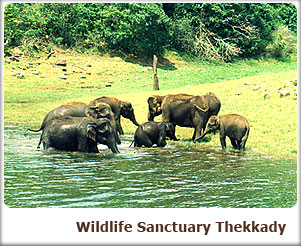 Day 10
Day 10
Thekkady:
Breakfast will be at the hotel.
Today you will visit the rare species of plants and animals by taking a short walk and enjoying the safari.
Periyar Tiger trail: A trekking expedition could be organized inside the Periyar Wildlife Sanctuary with the permission of the authorities. There is a set limit to the maximum number of people per expedition and it’s also subjected to meeting certain medical standards. This is because of the strenuous nature of this expedition through the dense remote jungles. The guides for this trail were poachers earlier and are now actively involved in protecting the unique ecosystem and the wildlife of the region.
Trekking and Mountaineering: Trekking is the best way to explore the scenic beauty of the mountainous terrain. Trekking expeditions could be undertaken at the Periyar Wildlife Sanctuary provided you take prior permission from the authorities. You have to take a guide approved by the authorities before you can go trekking inside the jungles.
Bamboo Rafting: This exciting adventure sport is available at the Periyar Wildlife Sanctuary. You can get in touch with the forest authorities for permission to do bamboo rafting in the Periyar Lake. This is one of the best ways to experience the area and to catch glimpses of wildlife at close quarters.
Overnight will be at Thekkady
Day 11
Thekkady – Kumarakom:
By Road 120Kms/04hrs
After breakfast proceed to Kumarakom.
Kumarakom, a prime backwater-tour destination, is world– renowned for its bewitching backwaters and picturesque tropical landscapes. This naturally blessed land has loads to offer even for the most discerning traveler. The unique geographical terrain of the region dispersed with vast paddy fields, palm groves, mangrove forests, lagoons, canals and backwaters make Kumarakom quite distinct from any other place in Kerala. Life in this small hamlet revolves around the Vembanad Lake – the life-line of Kumarakom; people here lead a unique water-based lifestyle quite different from the rest of the state.
Check into a traditional houseboat of Kerala Style and go on a leisurely backwater cruise along the lake on a thatched houseboat. The houseboat with all modern comforts lets you discover the countryside at your own pace. You will have lunch, dinner and breakfast in the Houseboat. A ride on the houseboat is a fabulous way to explore the fascinating beauty of the backwaters.
Cruise through the backwaters towards Alleppey. Lunch will be served on the boat. The menu is simple and traditional. The cook (chef) of the boat prepares the lunch from fresh materials and even you can have a peek at the recipe.
Tea and snacks would be served in the evening. The boat will be anchored in the backwaters along a paddy field and you can go for a stroll into the village or relax at the deck of the boat.
Dinner will be on the boat. Overnight will be at Houseboat.
Day 12
Alleppey - Cochin :
By Road 50Kms/02hrs
Breakfast will be on board the boat.
Cruise through the backwaters watching the children going to school and the village markets opening.
Disembark the boat at the finishing point where your driver will be waiting for you to drive to COCHIN.
The striking port city of Kochi or Cochin is a tourist's paradise. Lush mangroves, coconut tress reflected in the translucent waters of backwaters, ancient churches, cathedrals and fort - tourists on sightseeing tours of Cochin would find all these and more. Flanked by the Western Ghats on the east and the majestic looking Arabian Sea in the west, Kochi occupies a very strategic location and has been a significant trading zone and attractive tourist destination since time immemorial. The tradition and reputation of this enchantingly quaint port city has maintained till date. Here's a list of popular sightseeing places to be seen on a tour of India.
Relax & then proceed for the sightseeing.
Fort Kochi: Even a casual stroll through Fort Kochi located in the port city of Kochi in Kerala is enough to make you feel transported to another world and time. The architectural style of the buildings and the town layout easily make Fort Cochin distinct from other cities and towns of Kerala. Since Fort Cochin was under the possession of the Portuguese, the Dutch and the British at different points of time, the region still bear the influence of European architecture.
Bolghatty Palace: The splendid Bolghatty Palace is located on the Bolghatty Islands, in the Cochin city of Kerala. The appeal of the palace lies in the fact that it is among the oldest existing palaces built by the Dutch in India, during the pre-British times.
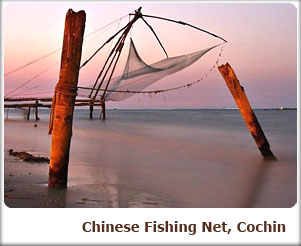 Chinese Fishing Nets: The Chinese fishing nets at Fort Kochi, located in the Kochi city of Kerala, make up a very popular tourist attraction. They are fixed land installations, which are used for a very unique and unusual method of fishing.
Chinese Fishing Nets: The Chinese fishing nets at Fort Kochi, located in the Kochi city of Kerala, make up a very popular tourist attraction. They are fixed land installations, which are used for a very unique and unusual method of fishing.
Mattancherry Palace: Even though it is austere in its appearance, the Mattancherry Palace of Cochin has a quaint charm of its own. The credit for building this landmark monument partly goes to the Dutch, who captured Cochin city of Kerala during the pre-British period.
Marine Drive: Marine Drive is a beautiful promenade in Kochi (Cochin), Kerala state of India. The Marine Drive is built facing the backwaters of Kochi. It is a popular hangout for the local populace as well as the tourists.
Jewish Synagogue: The Jewish Synagogue in the port city of Kochi is the oldest synagogue in all the Commonwealth of Nations. Thus, it comprises the topmost slot in the itinerary of the tourists visiting the city.
Pareekshith Thampuran Museum: Pareekshith Thampuran Museum is a very good archeological museum located near the Shiva temple, on the Durbar Hall Road at Ernakulam. This museum boasts of an impressive collection of 19th century paintings, ancient monuments and coins, scriptures made in stone and Plaster of Paris, murals as well as memorabilia belonging to the Cochin royal family.
St Francis Church: St Francis Xavier's Church at Fort Kochi was built in the year 1503, by the Portuguese traders. They came here with Admiral Pedro Alvarez de Cabral, via the same route taken by the legendary Portuguese explorer Vasco da Gama, who landed at Calicut in 1498.
Willingdon Island: The Willington Island contains the modern port serving Cochin city of Kerala. The island is an artificial man-made island created from the sand dug out while deepening Kochi port.
Museum of Kerala History: Do not take the Museum of Kerala History in the Cochin city of Kerala as any ordinary museum. The significance of this 'live' museum lies in the fact that it recounts the history of the land through magnificent and informative light and sound shows.
Overnight will be at Cochin.
Day 13
Cochin – Goa:
By Air
Breakfast will be at the hotel.
Transfer to the airport to take flight for Goa. Reach Goa and check into the hotel.
Whether you want a fun filled family holiday in the beach, midnight bonfire with a glass of Feni or beer on the sands, go shopping around by the beachside markets, enjoy some exotic cuisine, play water sports or just relaxed with only the murmur of the sea to disturb, there is a beach destination for all kinds of beach lovers in Goa. Staying in Goa is always an excellent experience.
Located in the Sahayadri Range in the Western Ghats with the Arabian Sea on its west, Goa occupies an important place in all tourist itineraries in India.
Beaches of Goa are much ahead of other beaches in India in terms of popularity and the facilities that are available here. The beaches here have been accepted as a matter of life, there are exotic cuisine backing the pleasure of have on sun and sand, and water sports facilities that include from water scooters to water gliding. To add on you can shake your legs for some time with a glass of fenny and beer, engaged in shopping on the beachside, or have midnight bonfire on the beach.
Overnight will be at Goa.
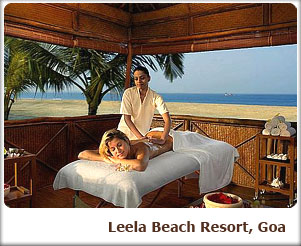 Day 14
Day 14
Goa:
After breakfast proceed for the sightseeing.
Places to see in Goa: Churches
Goa, Jewel of India, is studded with temples and churches, which remain as silent but forceful witnesses to the intense religious history of the diverse people who lived here. Hence a pilgrimage to Goa is a unique experience. Amongst the places to visit in Goa are Church of Our Lady of Rosary, The Rachol Seminary, Church of St. Francis of Assisi, The Se Cathedral and Basilica of Bom Jesus.
Places to visit in Goa: Temples of Goa
Noroa River, the Arvalem Waterfall, and the Brahma Camandolu or Water Pot of Brahma - the creator, in the old Goa Hills are the main Hindu pilgrimage spots in Goa. One more sacred place is Sidhanath Mountain in Borim Village. Amongst the myriad temples found here, there is a vast representation of the gods and goddesses of the Hindu pantheon, which testifies to the catholicity of the people's beliefs as well as their mutual tolerance. Indeed, Goa is could be loved just for this rare quality which one feels imperceptibly on even a short visit.
Overnight will be at Goa.
Day 15
Goa:
Breakfast will be at the hotel.
Relax and spend the day in leisure.
Overnight will be at Goa.
Day 16
Goa – Badami:
By Road 190Kms/06-07hrs
Breakfast will be at the hotel.
Drive to Badami - Capital of the ancient South Indian Kingdom of the Chalukyas.
The capital of the Early Chalukyas, Badami is picturesquely situated at the mouth of a ravine between two rocky hills. Badami is famous for its four cave temples - all hewn out of sand stone on the precipice of a hill.
Enter the first cave temple - past Shiva's door keepers - and there he is! The eighteen-armed Nataraja striking 81 dances poses!
The largest and most ornamental is the third cave temple dedicated to Vishnu. Overlooking the cave temples is a reservoir dotted with temples dedicated to Vishnu and Shiva. Also a must are the Bhutanatha temples that lend their name to the lake beneath the cave temples.
Overnight will be at Badami.
Day 17
Badami - Hospet:
By Road 214kms/05hrs
After breakfast proceed for the sightseeing.
There are several places of tourist interest in Badami that you may tour during your stay in Karnataka. Rock–cut cave Temples, Gateways, Forts, Inscriptions, and Sculptures that seem to come alive before your eyes. There are several monuments in Badami that were constructed during the 6th and 7th centuries. However, the town is best known for its cave temples, cut into the cliff face of the red sandstone hill and connected by flights of steps. They display the full range of religious sects, which have grown up on Indian soil. Two of them are dedicated to Vishnu, one to Shiva and the fourth is a Jain temple.
There's also one natural cave, which is a Buddhist One of the many masterpieces to be found in these caves is the famous, 18-armed Nataraja (Shiva) who if observed closely, strikes 81 poses. Cave 4, the last cave, is the only Jain Temple in Badami. The 24th Tirthankara-Mahavira is seated in a uniquely comfortable pose here, against a cushion in the inner sanctum. Also a must see are Bhutanatha temples that lend their names to the lake just beneath the cave temples. Take a dip in these green tranquil waters as it is said to have the healing properties. On the other bank of the ancient Bhutanatha Lake, astride whose shores the caves stand, is the shrine of Nagamma, the local serpent goddess, within a massive tamarind tree. Nearby, are two Shiva temples? Within the inner sanctum, on the edge of the water, He sits in a rare pose, leaning back, in all his awesome majesty.
Drive to Hospet. Reach and check into the hotel.
340 Kms from Bangalore lies Hospet. Its tourist importance lies in its proximity to Hampi, the site of the medieval Vijayanagara Empire, situated about 13 Kms away. The Tungabhadra Dam here harnesses the sweet waters of the Tungabhadra River. At the base of the dam is a garden styled along Japanese lines.
Overnight will be at Hospet.
Day 18
Hospet – Excursion to Hampi:
After breakfast proceed for an excursion to Hampi.
Hampi – Remains of the capital city of the Vijayanagara Empire are spread out over a beautiful, hilly landscape along the Tungabhadra. Founded in the mid-14th century, Vijayanagara became most powerful during the reigns of Krishnadevaraya and Achyutadevaraya. This was also the period of greatest architectural activity, as both these rulers commissioned several buildings in the royal capital and in other parts of their vast empire. Continuous conflict with the Bahmanis, then with Bidar, Bijapur and Golconda, ended in the Battle of Talikota, in which the Vijayanagara forces were defeated and the capital thoroughly sacked and burnt. Ruins of palaces, temple-complexes, monoliths, royal baths, and mosques still lie mostly deserted and dilapidated.
Overnight will be at Hospet.
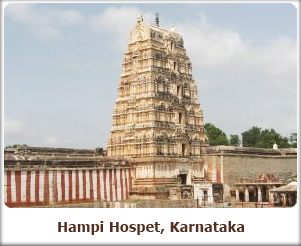 Day 19
Day 19
Hospet - Hassan:
By Road 420kms/07-08hrs
After breakfast proceed to Hassan. Reach Hassan and check into the hotel.
The Hassan City more fully and meaningfully known as the Simhasana Nagari originally, before the mutation of names made by foreign rulers is the administrative centre of the Hassan district which is the invaluable crown of the Karnataka state, whose glory is sung as being the dear offspring of the great Mother Bharata Maataa. This district is rich with natural sceneries and too with cultural wealth. It happens to be the confluence of three verities of areas namely the mountainous, the semi mountainous and the open field areas (Malenadu, Are Malenadu, and Bayalu Seeme). The Nandas, the Mouryas, the Kadambas, the Chalukyas, the Hoysalas, the Lords of Vijaya Nagar Empire, the Kings of Belur, and the Monarchs of Mysore - thus several dynasties had their dominions over this land. Belur and Halebidu have reveled in History as the Capitals of the Hoysala Reign. The very first written document of the Kannada Language has been exposed to the world by this district, in the form of Halmidi Saasana (Halmidi Inscription)
It was the Gangas and the Hoysalas who have contributed the immense treasure of sculptural art work to us to be handed over from generation to generation with proper care and protective measures. Empires and Kingdoms have come and gone, but the sovereign state of the Art of Sculpture erected by them has remained immortal unto this day.
Overnight will be at Hassan.
Day 20
Hassan – Excursion to Belur & Halebid:
Breakfast will be at the hotel.
Proceed for an excursion to Belur & Halebid.
BELUR: This quaint hamlet - 38 Kms from Hassan - is located on the banks of the river Yagachi. It was once the capital of the Hoysala Empire today made unforgettable for its exquisite temples. The Chennakeshava Temple is one of the finest examples of Hoysala architecture. It took 103 years to complete and you can see why. The facade of the temple is filled with intricate sculptures and friezes with no portion left blank. They are all there - awe-inspiring in their intricate workmanship. Inside are hand-lathe-turned filigreed pillars. The Veeranarayana Temple and the smaller shrines are well worth a visit.
HALEBID: Former Dwarasamudra in Hassan district is in Belur taluk and 27 Kms away from Hassan and was the capital of Hoysala after Belur. The Hoysaleswara Temple, dating back to the 12th century, is astounding for its wealth of sculptural details. The walls of the temple are covered with an endless variety of gods and goddesses, animals, birds and dancing girls. Yet no two facets of the temple are the same. This magnificent temple - guarded by a Nandi Bull - was never completed, despite 86 years of labor. The Jain basadis nearby are equally rich in sculptural detail. Belur and Halebid are 222 and 216 Kms from Bangalore, respectively. Channarayapatna, Ramanathpur, Gorur and Manjarabad are the other places of interest around Hassan.
Overnight will be at Hassan.
Day 21
Hassan – Mysore:
By Road 110kms/04hrs
Breakfast will be at the hotel.
Proceed to Mysore. Reach Mysore and check into the hotel.
Mysore is a major tourist city of Karnataka. The city was the erstwhile capital of the state and hence has played an important role in the history of the state and of South India. Today it has developed into a modern city like many other cities in the country. But this city has not lost touch with its rich historical and cultural legacy. Mysore city is a favorite tourist destination in Karnataka. Tourist from within the country and from outside come see the splendor of the city of Mysore. The city has a number of places a person can visit. There are a number of Royal buildings, gardens, waterfalls, temples, museums and modern amusement parks.
The city of Mysore is known as the 'City Of Palaces'. There are number of buildings built by the Royal family and are exquisite examples of Dravidian architecture and display grandeur and lavish life lead by the Emperors while they ruled the state. Apart from the Palaces there are number of other tourist’s attractions that one can visit in Mysore. One of the popular spots is the Chamundi hills and the temple on top of the hills. This prominent landmark of Mysore is a favorite destination for the locales as well.
Relax and then proceed for the sightseeing.
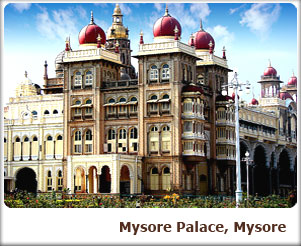 The Chamundeswari Temple, atop the hill of Chamundi, is of great religious significance. It is dedicated to the Goddess Chamundi or Durga, who killed the demon king. This temple earlier was a small one, but later was expanded under the Wodeyar rule. It displays Dravidian influence in some of its architecture. It is quadrangular in shape, and there is a statue of the Lord Ganesha on the doorway.
The Chamundeswari Temple, atop the hill of Chamundi, is of great religious significance. It is dedicated to the Goddess Chamundi or Durga, who killed the demon king. This temple earlier was a small one, but later was expanded under the Wodeyar rule. It displays Dravidian influence in some of its architecture. It is quadrangular in shape, and there is a statue of the Lord Ganesha on the doorway.
Another temple to see is the Mahabaleshwar Temple, which is said to be older than the Chamundeswari Temple, which somehow lost its importance with the latter gaining significance. Inside this temple you can see images and statues which have been built in the styles of Hoysala, Ganga and Chola art.
The Mysore Palace is said to be the most magnificent and looks even more captivating on festive nights when it is lit up with as many as 97,000 light bulbs. Located in the city's centre, this is said to be the fourth one that stands there on the very same site.
This Palace is also called the Main Palace or the Amba Vilasa Palace, and it has drawn influences from Dravidian, Oriental, Roman and Indo-Saracenic architectural styles and is a three storeyed structure made of grey granite. You enter this palace through a Doll's Pavilion called Gombe Thotti, which is home to dolls from the 19th and 20th centuries.
Another interesting feature is the seven cannons in front of this pavilion which are still used at the beginning and end of the Dusshera festival. The Palace houses 12 temples.
The museums talk about the rich cultural past of the city. A museum to visit is the Jayachamarejendra Art Gallery inside the Jaganmohan Palace, which is a reservoir of rare art, artifacts, and paintings. A three-storeyed structure, the ground floor comprises paintings depicting the lineage of the Mysore Kings; the first floor with paintings from artist’s world over and in India; the second floor, home to many musical instruments; and the third floor once again with a gallery of paintings depicting the Dusshera processions.
You could do some climbing to catch a great sunrise from the Chamundi Hill or a walk to the lakes.
Try some fine South Indian dishes such as the famous Mysore Masala dosa and the Mysore Pak sweet.
Mysore is famous for its silk sarees and sandalwood. You can shop at places like Cauvery Art and Crafts Emporium, and on roads like Ashoka, Sayyaji Rao and Devaraj Urs.
Overnight will be at Mysore.
Day 22
Mysore – Srirangapatnam – Bangalore:
By Road 150Kms/04hrs
After breakfast proceed to Bangalore visiting Srirangapatnam enroute.
On the way visit Srirangapatnam - 16 km before Mysore, this fort was the stronghold of Tipu Sultan, son of Haider Ali. Tipu made a last minute ditch against the British in 1799 before surrendering his kingdom. Among the many fort buildings still intact, are Tipu's airy Summer Palace and his tomb at the Darya Daulat Bagh (garden). Here, is also the celebrated Sri Ranganatha Temple.
Reach Bangalore and check into the hotel.
Bangalore is a booming city and considered fifth largest and the fastest growing city in Asia. Bangalore combines a quaint old world charm with the hustle and bustle of a modern metropolitan city. It is a delightful place with an amalgamation of various rich cultures, crafts, and heritage centers. This city while enjoying the reputation of being a modern, high-tech city, still offers a lot of places of historical interest for the avid sightseer to explore. A trip around the city can be very interesting and provides a varied sightseeing experience with Palaces, museums, temples, churches and gardens. It has an enviable posterity and presents much to be discovered. Despite being one of Asia's fastest growing cities, Bangalore remains one of the most elegant metros in India. A well-planned city, with tree-lined avenues, a large number of parks, gardens and lakes, Bangalore is aptly called India's garden city. Bangalore is even gaining the status of the "Floriculture Capital of India" due to the present blossoming of flower exports from the city. The beautiful parks like the Lalbagh and Cubbon Park are indeed a treat to the eyes.
Enjoy shopping or just sit in one of the numerous modern pubs in downtown area just enjoying the latest music and crowd. It will be a nice experience as the weather in this city is pleasant all through the year.
Overnight will be at Bangalore.
Day 23
Bangalore:
After breakfast proceed for the sightseeing.
Cubbon Park: Lord Cubbon laid down the 300-acre park in 1864. A perfect place for joggers and nature walkers, it also has red Gothic structures to see such as the State Central Library with its rare treasure of books, architectural style and fluted pillars, the High Court, the Cheshire Dyer Memorial Hall, Ottawa Chatter, Museum, Century Club and the Press Club.
Lalbagh Gardens: A small fruit orchard of Hyder Ali, this garden had the glory of Tipu Sultan introducing several exotic trees here such as Cypress, Thuja, Junipers, Grapes, Guavas, Raspberries and Strawberries while John Cameron's period was certainly its 'Golden Era'. The Lalbagh Glass House once displayed the flora imported from England.
Vidhana Soudha: An imposing 46m high Bangalore granite monument that resembles the Temple architectural style houses the Legislative Chambers of the state government. The building has 22 departments and 300 rooms, four domes on all its corners and the four-headed lion.
Tipu’s Palace: Similar in many ways to the Summer Palace of Tippu Sultan at Sriangapatna, this palace was begun by Haider Ali and completed by Tippu in 1791. Known as `Rashk-e-jannat' (Envy of Heaven), it has massive wooden work and is known for five exquisitely ornamented arches with beautiful minarets and paintings on walls and ceilings.
Gandhi Bhavan: The Gandhi Smarak Nidhi (memorial of Father of India, Gandhiji) in the Gandhi Bhavan exhibits pictures and photos depicting Gandhiji's life from early childhood till the day of his death. One can also read copies of Gandhiji's letters to famous personalities of his time to fully comprehend his philosophy and his views on various subjects
Overnight will be at Bangalore.
Day 24
Bangalore - Departure:
Today as per the flight timings you will be transferred to the airport to take flight back home with sweet memories of the SOUTH INDIA TOUR.
...........................................................................TOUR ENDS...........................................................................INCLUSIONS:
- ACCOMODATION AT SUGGESTED HOTELS,
- DAILY BUFFET BREAKFASTS,
- AIR CONDITIONED VEHICLE WITH DRIVER FOR THE TOUR,
- SIGHTSEEING TOURS AS MENTIONED IN THE ITINERARY,
- MEET AND ASSIST SERVICES ON ARRIVAL AND DEPARTURE,
- ENGLISH SPEAKING GUIDE AT APPLICABLE PLACES,
- BHARATNATYAM DANCE PRESENTATION IN CHENNAI,
- AUROBINDO ASHRAM VISIT AT PONDICHERRY,
- EVENING PRAYER CEREMONY AT MEENAKSHI TEMPLE – MADURAI,
- OVERNIGHT STAY IN HOUSEBOAT,
- ALL MEALS IN HOUSEBOAT,
- DAY PACKAGE WITH BAMBOO RAFTING IN PERIYAR,
- SPICE PLANTATION TOUR IN PERIYAR,
- ELEPHANT RIDE IN PERIYAR,
- KATHAKALI DANCE PRESENTATION IN COCHIN,
- ALL APPLICABLE TAXES AND SERVICE CHARGES, AND
- ALL PARKING WITH DRIVER ALLWANCES AND ROAD TAXES.
EXCLUSIONS:
- LUNCHES & DINNERS,
- MONUMENT ENTRANCES,
- CAMERA CHARGES AT THE MONUMENTS,
- PORTER CHARGES,
- TIPS &
- PERSONAL EXPENSES.

